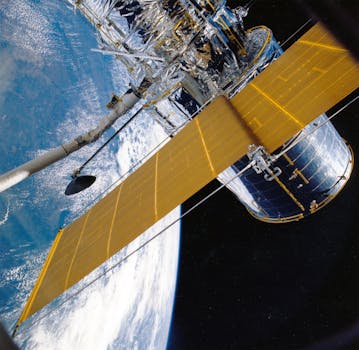GEO Satellites: Understanding the Technology and its Applications

GEO Satellites: An Introduction to the Technology
GEO satellites, or Geostationary Earth Orbit satellites, are a type of satellite that orbits the Earth at an altitude of approximately 36,000 kilometers. They are stationed above the equator, where they remain stationary relative to a fixed point on the Earth’s surface. This unique characteristic allows GEO satellites to provide continuous coverage of a specific region, making them ideal for telecommunications, weather forecasting, and other applications.
The concept of GEO satellites was first proposed by science fiction writer Arthur C. Clarke in 1945, and the first GEO satellite, Syncom 2, was launched in 1963. Since then, the technology has evolved significantly, with advancements in satellite design, propulsion systems, and communication equipment. Today, GEO satellites play a vital role in global telecommunications, providing internet connectivity, voice and data services, and broadcasting television channels to millions of people around the world.
Applications of GEO Satellites
GEO satellites have a wide range of applications, including telecommunications, navigation, weather forecasting, and Earth observation. In the telecommunications sector, GEO satellites are used to provide internet connectivity, voice and data services, and broadcasting television channels. They are particularly useful in areas where terrestrial infrastructure is limited or non-existent, such as in rural or remote regions.
In addition to telecommunications, GEO satellites are also used for navigation purposes. They provide location information and timing signals, which are used in GPS systems to determine the exact position of a receiver on the Earth’s surface. This technology is essential for modern navigation, and is used in a wide range of applications, from aviation and maritime to automotive and personal navigation.
GEO satellites are also used for weather forecasting and Earth observation. They provide images of the Earth’s surface, which are used to monitor weather patterns, track storms, and predict climate changes. This information is essential for meteorologists, who use it to forecast weather patterns and issue warnings for severe weather events.
Significance of GEO Satellites in the Industry
GEO satellites have revolutionized the telecommunications industry, providing global coverage and facilitating international communication. They have also enabled the development of new technologies, such as GPS and satellite television, which have transformed the way we live and work.
The significance of GEO satellites can be seen in their widespread adoption by telecommunications companies, governments, and other organizations. They are used by companies such as Intelsat, SES, and Eutelsat to provide internet connectivity, voice and data services, and broadcasting television channels to millions of people around the world.
GEO satellites have also played a crucial role in disaster response and recovery efforts. They provide critical communication services, such as voice and data connectivity, during emergencies, and enable the coordination of relief efforts. This is particularly important in areas where terrestrial infrastructure has been damaged or destroyed, and GEO satellites are often the only means of communication available.
Future of GEO Satellites
The future of GEO satellites looks promising, with advancements in technology and increasing demand for satellite-based services. The development of new technologies, such as high-throughput satellites and satellite constellations, is expected to further enhance the capabilities of GEO satellites and expand their applications.
High-throughput satellites, such as those developed by companies like ViaSat and Hughes Network Systems, offer faster data speeds and greater capacity than traditional GEO satellites. They are designed to provide high-speed internet connectivity, and are particularly useful for applications such as video streaming and online gaming.
Satellite constellations, such as those developed by companies like SpaceX and OneWeb, are networks of satellites that work together to provide global coverage. They offer a range of benefits, including improved connectivity, increased capacity, and enhanced reliability. Satellite constellations are expected to play a major role in the future of telecommunications, and are likely to revolutionize the way we communicate and access information.




